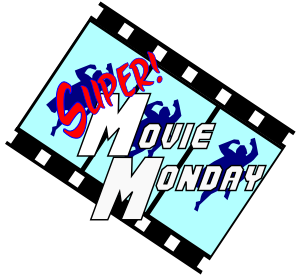

Lots of stuff to cover on this one after the fold. And remember, you can click on any picture to embiggen it for clearer viewing.
Okay, so when I was recapping Tim Burton’s Batman, I took two weeks to cover it. I’m still considering whether to spend three weeks on this bad boy.
Because this movie is so much bigger than life. Not only is it a rollicking adventure on its own, but it also redefined Superman for a viewing audience no longer familiar with the radio program. And it’s a fascinating example of one of those bloated productions that can so easily go wrong, as well as the movie that was arguably the progenitor of every big-screen superhero film today, from Batman to Iron Man to My Super Ex-Girlfriend.
The film was the brainchild of Alexander and Ilya Salkind, a father-son team who had recently scored big hits with the comedy-adventures The Three Musketeers and The Four Musketeers. Ilya Salkind proposed the film to his father in 1974, before Jaws and Star Wars rewrote the rules for Hollywood blockbusters. But to Ilya, the time seemed right for a BIG film, and Superman was a character with worldwide name recognition who had not appeared in live-action since the George Reeves TV series was ended in the late 50’s.
So they assembled the super cast and crew to end all casts and crews and set to work making the film. Seriously, it seems like half the creative supervisors on the film had worked on 2001, A Space Odyssey, and the other half worked on Star Wars (at least one worked on both).
For the screenplay, they turned to Mario Puzo, the novelist who had written The Godfather, along with David Newman and Robert Benton, the team that had written Bonnie and Clyde. When Robert Benton had to drop out of the production, David’s wife Leslie Newman came on board, and later Tom Mankiewicz, an old hand who had worked on several Bond pictures, came in to help shape the picture to director Richard Donner’s satisfaction. Donner was a hot property, due to having directed the sleeper hit, The Omen.
So with a crew like that, how do you find a cast just as big? One word. Brando.
Marlon Brando was the biggest name in Hollywood at the time, and the Salkinds paid through the nose to get him, which caused problems down the road. For Superman, they considered a bunch of ridiculously inappropriate big stars, then went with unknown Christopher Reeve.
Wow, look at the time. You mean the movie hasn’t even started yet?
Of course, just to keep up the pattern, this Superman adventure is from a different studio than the cartoons and the serials. First was Paramount, then Columbia, now it’s time for the iconic Warner Brothers’ shield.

Maybe not. I for one am mighty glad the old shield came back.
The movie opens with a strange sort of framing sequence. Curtains opens to reveal a small black-and-white movie screen where a title says, “June 1938.” Then we see an issue of Action Comics, only this one doesn’t feature the iconic cover of Action Comics #1, which introduced Superman in June 1938.

Instead, as we page through the comic, we hear about how the downtrodden citizens during the Depression were inspired and defended by heroic newspaper reporters of the Daily Planet. We then dissolve to the globe atop the Daily Planet building, then move out into space and the opening titles.
The titles, presented to the stirring strains of John Williams’s Superman theme, take forever, mainly due to the inordinate pride they took in using the slitscan technique to zoom the titles onto the screen (the technique is similar to the one used to produce the climactic “trip” sequence in 2001, A Space Odyssey, neither the first nor last time you’ll hear that film mentioned in connection with this one). The title card above does not appear in the film but is a combination of three separate screengrabs, as first the Superman shield, then the title, zoom onto the screen. There are eighteen, count ’em, eighteen principal actors listed in the opening credits, and nearly every one is zoomed onto the screen individually.
Finally, the credits end and we arrive at a red sun orbited by a cold, blue planet. This is Krypton, and for the first time, we aren’t told about it by a narrator.
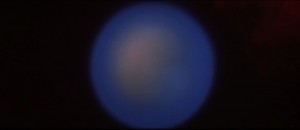
The surface of the planet is frozen and forbidding, and dominated by gigantic cities built out of slabs of snow and crystal. This is not the Krypton we thought we knew.

While this is being shown, we hear a grandiose fanfare that was written by John Williams under specific orders to make it sound like 2001, and it really does.
As we move inside a giant white dome, we meet Brando, playing crusading District Attorney Jor-El, currently prosecuting three criminals held prisoner in a really cool swirly thing.
Wait a second, Superman’s dad is a lawyer? When did this happen?
The criminals–Non, Ursa and General Zod–have been convicted of treason and are pronounced guilty. As Jor-El is leaving, Zod makes a grandiose speech about how Jor-El and his heirs will someday bow to Zod. That will be important later, but not in this movie, because now the wicked crystal comes swooping down from space and gobbles up the three criminals.
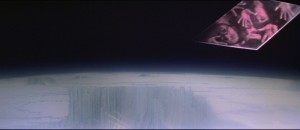
And that’s it for them in this movie. Next we find out that Jor-El is not just a lawyer, but is also a scientist, as he argues with the ruling council that Krypton is about to explode. And not only are all the Kryptonians wearing some trippy Scotchlite front-projection clothes, but Jor-El is wearing the Superman shield and rocking the Superman forehead curl. The other elders on the council are also wearing odd-looking crests, to try to explain away Brando’s wearing the “S” as a family crest of some sort. It’s not really an “S” at all, a concept that got a lot of traction on the Smallville TV series as well.
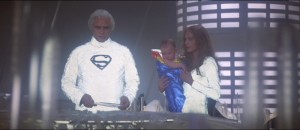
That him with wife Lara above, and baby Kal wrapped in shiny blankets in the iconic Superman colors, a nod to the old origin story that Superman’s super-suit was sewn by Ma Kent out of Clark’s super baby-blankets (really). Jor-El has promised not to spread panic or flee the planet, but being a lawyer, he words it so that he can at least get little Kal-El to safety. After a debate with Lara about how Superman will be strong but lonely, Jor-El reads a long speech off of notes in the ship about how awesome he is.
“You will carry me inside you all the days of your life. You will make my strength your own, see my life through your eyes, as your life will be seen through mine.” I’m guessing they had to write this shit to cater to Brando’s ego, but seriously, it’s like Jor-El’s the Obama of Krypton. Everything’s about him.
Jor-El launches the rocket just as the red sun is going nova. And the spaceship, by the way, is nothing like the Flash Gordon redux ship we’ve seen in every version of Superman’s origin in the past (both comics and screen), but a cool-looking spiked crystalline ball that looks organic to the cold Krypton that’s about to get a hell of a lot hotter.
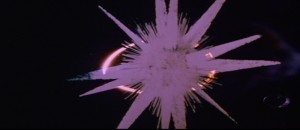
The planet blows up real good. And thank God they’ve never released a Special Edition where they redid the explosion to add a goofy corona-shockwave.

We’re about twenty minutes into the picture, and of the 18 principal actors listed in the opening credits, almost half of them are done for.
So the spaceship is traveling through what we’re told are six of the 28 known galaxies, and little Kal-El’s jamming to some righteous travelling music, like Boston or something. No, actually, his iPod comes preloaded with years of speeches by Jor-El. He really is Obama.
So Kal-El’s dad lectures him all the way to Earth, and then the ship crashlands in Kansas next to kindly old Jonathan and Martha Kent, where we learn that Dad was so busy making up his playlist, he forgot to include clothes for Kal.
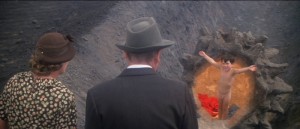
Can you imagine growing up as the kid whose pecker was in Superman? The kid’s name, by the way, is Aaron Smolinski, and he still acts sometimes, when he’s not picking up women in bars by telling them he has Superman’s dick or something. “Hey, you’ve already seen it. I’m just offering you the chance to see it up close and grown-up.”
Years later, Clark is the teenaged athletic manager for his high-school football team. Dishy cheerleader Lana Lang asks him if he wants to come “listen to records,” if you know what I mean…
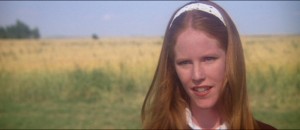
But unfortunately, the mean jocks sabotage Clark’s shot at the title and he is left alone. In his frustration, he punts a football into orbit.
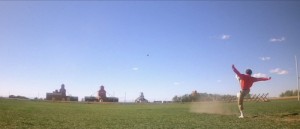
And this will be important later, because the ultimate storyline of the film (or I should say, of the first two films, which were written as basically one huge script by Puzo, and were originally supposed to be filmed simultaneously) turns on Clark’s sexual frustration. I mean, his big confrontation with those criminals from the opening of the film, who won’t be seen again in this movie, turns on exactly how far Clark is willing to go to get his ashes hauled, which was also the point of that big “powerful vs. lonely” debate between Jor-El and Lara. It all pays off in the next film, not this one. Seriously, they should have made that football the thing that breaks the Kryptonians out. It would have been more thematically apt.
Now we get to see Superman’s powers in action, as young Clark outruns a train. And who should be watching but some random little girl whose parents just happen to be Kirk Alyn (though you can’t tell because his back is turned) and Noel Neill, the Superman and Lois from the movie serials.
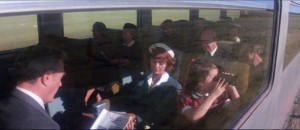
An extended version of the scene makes it clear that the little girl is actually a young Lois Lane, but we don’t get that here in the theatrical version.
Young Clark actually makes it to his house before the car carrying Lana and friends, and I guess this is as good a time as any to address the tricky subject of time in this film. There’s a website with some excellent background articles on the making of the Superman films here, and in discussing the development of the screenplay, he mentions several times that the various drafts of the screenplay ended up making for some confusing contradictions in the timeline. But, he says, the problems were all solved before the film made it to the screen.
Well, I hate to break it to the Internet, but that’s wrong. And here’s where I’ll start to build that case. Remember that when the film opened, the screen said, “June 1938?” Now here’s teenage Clark, around 16 or 17 years old maybe, and the kids are racing around in a car listening to Bill Haley and the Comets singing “Rock Around the Clock.” That song originally came out in 1955, 17 years after 1938, so this scene fits in that timeline. Kal-El was born and launched from Krypton in 1938 and is 17 in 1955, when “Rock Around the Clock” is current. All’s well for now.
Jonathan Kent happens to overhear Clark telling his friends that he outran their car home on foot, and gives Clark a lecture about using his powers for something better than showing off or scoring touchdowns. And it bears mentioning at this point that it’s almost like we’re watching a different movie from the one we watched for the first twenty minutes. Gone are the artificial colors, the affected accents, the overbearing pomposity. Now we have Glenn Ford and Phyllis Thaxter turning in some wonderfully understated, naturalistic performances while overwhelmed by amazing sweeping vistas beautifully photographed by the late Geoffrey Unsworth, who also directed photography on 2001, A Space Odyssey.
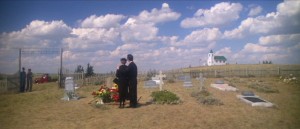
Well, until Jonathan dies, in which case, it’s just Phyllis Thaxter and Jeff East as Clark being overwhelmed by sweeping vistas. And though Clark is mourning the fact that his powers proved unable to save his father, the truth that he never faces is more disturbing. Jonathan had his heart attack right after Clark urged him to run back to the house. Clark wasn’t just unable to save Jonathan; he killed him.
But before Clark is forced to deal with that truth, he is summoned out to the barn by a mysterious glowing tube of Prell from his old spaceship.
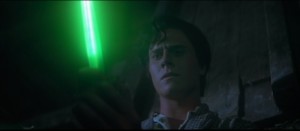
Clark leaves Smallville and his elderly mother to follow his destiny. And somehow he ends up at the North Pole, where he throws away the glowing crystal, which promptly builds him a Kryptonian house.
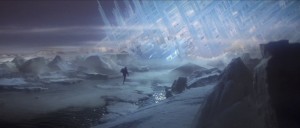
And once again we encounter what will become the theme of my discussion of this movie, which is that this film represents the first big break with the radio show, meaning that all further versions of Superman will to some extent or other reference this version of Superman instead of the old one. What’s that you ask? What about the comics? Are you new?
Clark enters the Crystal Cathedral and finds a control console. Suddenly, a hologram of Jor-El appears and basically says, “I’m here to serve you, son. Ask me what you want to know, and I’ll see if I can help.”
Clark, the idiot, asks “Who am I?” at which point Jor-Bama talks for 12 years, taking him on a virtual journey back through space to Krypton (Kal-el’s second space montage and the audience’s third), while lecturing him (again) on everything he lectured about on the trip over.
Oh, and remember how I was mentioning the timeline earlier? As Jor-El is speaking to Clark, he mentions that Clark is now 18, but that he–Jor-El–has been dead for thousands of years. Which would apparently seem to mean that Clark experienced relativistic time-dilation while traveling through the six galaxies in his way to Earth. Which would make sense, except that we, as an audience, traveled to Krypton to see all that stuff going down in June 1938. So maybe that opening date was just poetic or something, but the mid-50’s date of the Smallville sequence seemed to confirm it. Weird.
But what we do know is that Clark was 18 when he entered the Fortress of Solitude and that 12 Earth years passed while he was inside. So when we emerge on the far side of the space montage, with Jor-El saying that the people of Earth have the potential for good, “which is why I sent them my only son,” Clark is now 30 and Jor-El has progressed from Obama to God the Father.
And now, 45 minutes in, we finally see Superman in costume, but only in long shot as he flies out of the Fortress. Then we cut to Metropolis.
Welcome to the wonderful world of 1968! Only it’s 1978. WTF?
Continued next week…

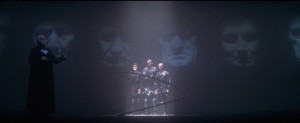



The Warner Communications byline should have appeared underneath “The Big W” logo and the words: “RELEASED BY WARNER BROS.” on Superman: The Movie (1978) on the end of that film as well as Superman II (1980), Superman III (1983) and Supergirl (1984) which should have had the 1984 WB shield, the big W with the words above and below “DISTRIBUTED BY WARNER BROS. A WARNER COMMUNICATIONS COMPANY”. The same on the end of Superman IV: The Quest For Peace (1987) but with a bannerless WB shield much like the short lived logo from early 1972.